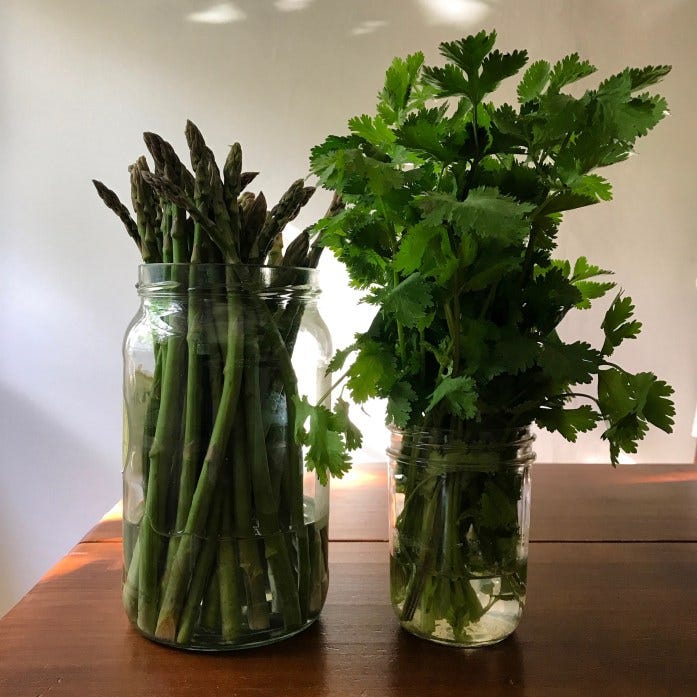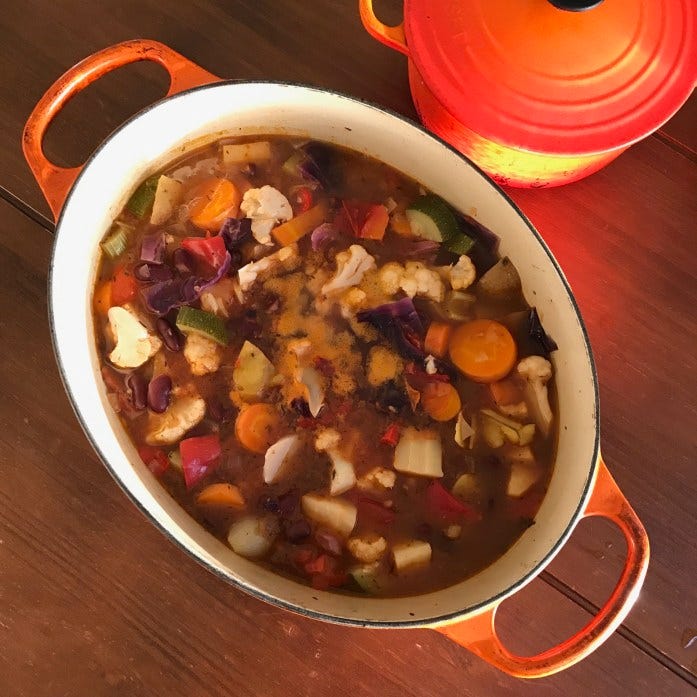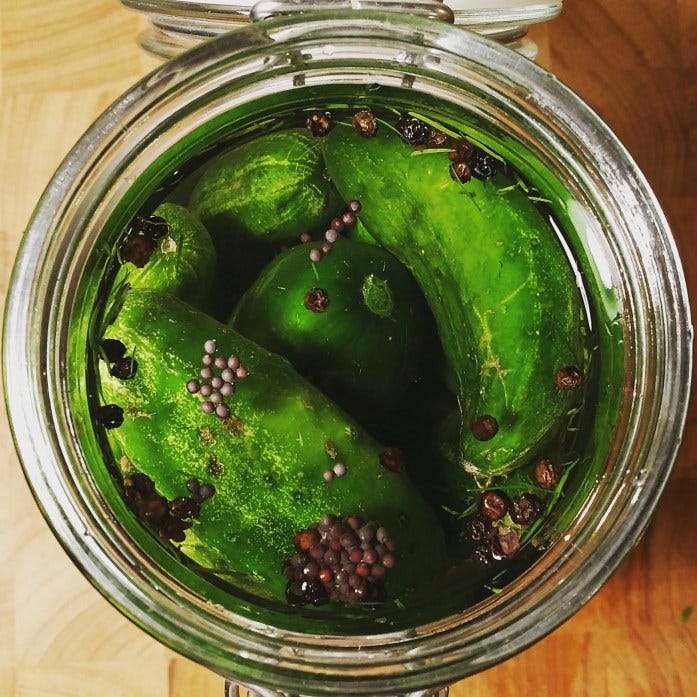Conserve Energy in the Kitchen During Heat Waves and Peak Demand
This week in Northern California, PG&E asked residents to conserve energy in order to prevent rotating outages
Conserving energy is always a good idea but the concept really hits home when the mercury hits triple digits during Covid so we can’t seek out relief at a movie theater or a mall or a skating rink, and everyone who can huddle at home with the air conditioners or fans blasting is huddling, straining the grid and giving PG&E the power to turn off the power.
So, while I still have wifi and a fully charged device, I thought I’d share some tips for conserving energy in the kitchen.
The energy to feed ourselves
Here in the U.S., food-related energy accounts for about 16 percent all the energy we consume nationally. That energy includes all the steps in the food supply chain—growing and processing the food, packaging it, shipping it, storing it, preparing it and dealing with all the food we waste (about 40 percent of what we produce but that’s another newsletter for another day).
This newsletter focuses on reducing food-related energy consumption at the consumer level. Many of these energy-saving ideas also save money and time, sort of a three-for-one.
To give you an idea of the amount of energy required to power even a small appliance—and to motivate you to implement some of the 19 energy-reducing tips below—watch this short video of an olympic cyclist versus a toaster. It’s slightly terrifying…
Plan ahead
1. Soak grains and dried beans to cut cooking times. I love steel-cut oats but they cook for a long time—about 45 minutes. If you start them the night before though, you bring them just to a boil, turn off the heat and let them sit all night to finish cooking. In the morning, heat them up. (Here’s the recipe.)
2. Thaw frozen food out in the refrigerator before cooking it or heating it. To cook tomato-based dishes in the winter, I grab a jar of the tomatoes I roasted and froze in the summer and thaw them in the refrigerator the night before I need them. I don’t waste energy thawing them out in a microwave or in hot water (which may also break my jar).
Refrigerate wisely
3. Keep it in the cupboard. Many foods we tend to refrigerate (e.g. mustard, soy sauce, hot sauce) don’t need refrigeration and many foods should not go in the refrigerator at all. Bread dries out in the refrigerator so keep it at room temperature. Keep tomatoes in there only if you want to render them flavorless. Store potatoes and onions in a cool place other than the refrigerator and separate from each other (they don’t get along). For info on storing produce, see this post.
4. Cool it. Allow hot foods to reach room temperature before storing them in the refrigerator or freezer. If you put hot food in there, your appliance has to work harder—and consume more energy—to cool down the food.
5. Adjust the temperature. According to the USDA, most food keeps well at a temperature below 40ºF. If some of your food freezes in your refrigerator, you have set the temperature too low (food freezes at 32ºF). Consumer Reports suggests a temperature of 37ºF.
6. Downsize. If you’re in the market for a new refrigerator, consider choosing a smaller energy-conserving one. A smaller refrigerator can also improve your health and reduce food waste because the larger the refrigerator, the more food you buy, the more food you eat, and the more likely some of all that food stashed in there will end up in the trash.

Asparagus and parsley stored in jars of water at room temperature
Cook efficiently
7. Put a lid on it. Lidded pots retain the heat inside and bring water to a boil quicker. Most people know this one and I almost didn’t include it. But I think it’s worth repeating.
8. Go small. Use a smaller pot if possible and make sure to heat it on a smaller burner. A big burner consumes more energy than you need for a smaller pot.
9. Heat less water. If you need water for one cup of tea, boil water for one cup of tea, not seven. Conventional wisdom says you must cook pasta in a large amount of boiling water. Actually, you can cook it in a small amount of water. You conserve both energy and water with this one.
10. Turn down the heat. Once your pot of water has boiled, turn down the heat—let’s say to medium or medium-low depending on your stove. You don’t need the gas (or electricity) cranked up all the way to continue boiling the water.
11. Add some pressure. Use a pressure cooker but only if you want to save hours of time in the kitchen and cut your energy consumption by at least half. Soaked beans cook in mere minutes. Here’s how I use mine.
12. Use a slow cooker. These appliances consume little energy and you can walk away from them while they cook your food. Here’s a post on cooking beans in a slow cooker.
13. Double a recipe. Cooking a vat of soup on top of the stove requires more energy that cooking a small amount but not as much as cooking two separate pots of soup from scratch on two different days. Save lots of time with this one.
14. Prep first. This one depends on your cooking style. If you can chop efficiently like a pro, you may want to heat up your oven and start boiling water before you prep ingredients. For most of us, prepping and measuring before turning on the heat will conserve that energy until we need it.
15. Cut it up. When you cook that vat of soup, chop the vegetables into smaller pieces. They’ll cook faster.
16. Choose heat-retaining pots. If you need new pots or are about to buy your first pots, consider investing in cast iron (enameled or not). Cast iron retains heat really well. If you cook a vat of minestrone soup in a Dutch oven (an enameled cast iron pot) for example, it will stay hot in the pot long after you turn off the heat. Set it on the table and it will stay hot during dinner.
17. Cook a bunch of food at once. If you have the oven on for roasting vegetables, cooking a pot pie, making macaroni and cheese, baking a loaf of bread—whatever—throw something else in there, maybe some quick bread, muffins, crackers…those potatoes that need using up… On the other hand, if you have a toaster oven, use that to cook something small.

A vat of minestrone cooked in an enameled cast iron Dutch oven
Go off the grid
18. Harness the sun. I have experimented a bit with a solar food dehydrator. You can read about that here and here. Most people don’t have a solar food dehydrator lying around but a reader sent me a link with instructions for dehydrating food in the car on a hot sunny day. (So cool!)
19. Let the microbes do the cooking for you. Fermented foods consume very little—if any—energy to prepare. To make my fermented salsa, for example, I merely chop and salt all the vegetables—tomatoes, onions, bell peppers, jalapeño peppers, garlic, cilantro and so on—pack them into jars and set those out on the counter at room temperature for a few days while the food ferments. I don’t cook anything. I don’t turn on a burner.
Fermented foods on my blog that require zero energy to prepare include:

In other newsletters…
Thank you to all who attended my virtual screening of The Story of Plastic film last month. Here is a list of steps to take to turn off the corporate plastic spigot.
Until next time. Stay well, stay cool,
Anne-Marie




Thank you for this timely list. One more way to save energy, in addition to dehydrating food with the sun, you can use a solar cooker (I have a simple one made of cardboard & foil) to make anything you'd normally cook in a slow cooker. This is a new to me, but so far I have tried: fruit cobbler, lentil soup, and carnitas. They all turned out great (the soup was actually better than in my slow cooker!).